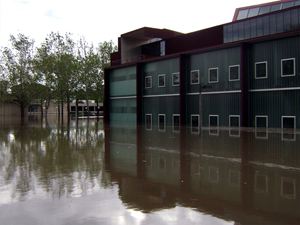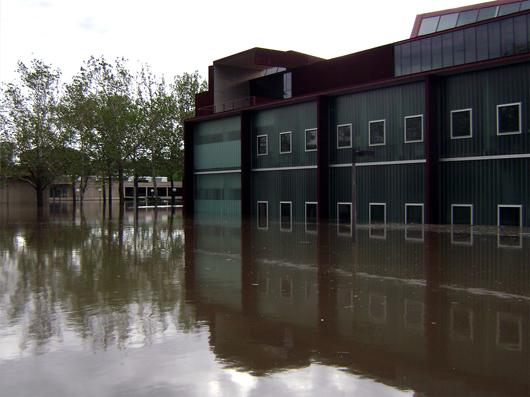
IOWA CITY, Iowa (AP) – When the Iowa River rose to historic levels in June 2008, floodwaters washed away the University of Iowa arts campus that was nestled on its scenic banks.
In what turned out to be the costliest natural disaster in Iowa history, two art and art history buildings and the university’s art museum were damaged. Hancher Auditorium, one of Iowa’s most prominent performing arts venues, was filled with water. Nearby, the school of music and a recital hall were wrecked too.
Seniors will graduate this spring having never known those buildings as anything other than vacant eyesores. But the university, with help from state and federal officials, is slowly but surely rebuilding each in a way that will transform the campus and Iowa City.
The recovery reached a milestone Wednesday, when the Iowa Board of Regents approved plans to build a new $175 million Hancher Auditorium, a $152 million school of music across campus in the heart of downtown Iowa City, and a $77 million art building. About two-thirds of the money will come from the Federal Emergency Management Agency while the rest will come from insurance, donations and other sources.
“To say this has been a long time coming for some of us would be an understatement,” UI President Sally Mason said.
Mason, who took office months before the flood, said the disaster has defined her presidency. She credits university employees and students with making the most of a bad situation, holding together programs with creative solutions while waiting for permanent building replacements.
It hasn’t been easy or ideal. The school of music is spread out among seven buildings all over campus, and lost space to hold concerts. The art school has been holding classes in a former big box store off campus that was transformed into a makeshift academic building after the flood. The museum’s art collection has been relocated to a Davenport museum and elsewhere around campus. Hancher is in its fourth season without a permanent site and is using more than a dozen different locations for events this year.
Against that backdrop, university officials say rebuilding cannot come soon enough. And they say having plans for quality buildings, even if construction won’t be finished for a few years, will help recruit students and give hope to employees who suffered through the flood and its chaotic aftermath.
Hancher Director Chuck Swanson said the theater has used a marketing theme of “can’t contain us” since the flood and employees have been creative in finding new partnerships. But after four years, he said, not having a venue is “getting to be a really big challenge” and it’s getting hard to find sites and maintain support from donors.
“We are really looking forward to having a new home,” Swanson said.
The new auditorium, located on a hill above the current site that is 9 feet above the 500-year flood level, will seat 1,800 with two balconies and feature top-notch acoustics for orchestras, bands, opera and other performers. Lobby areas will have glass from floor to ceiling that will allow for views of the river and campus. Features such as the box office, rehearsal space and dressing rooms will be located throughout its six stories.
Crews are expected to demolish the old Hancher, the Voxman music school and Clapp Recital Hall this fall. The new auditorium is scheduled to be finished in December 2015.
Several blocks down the river, the new art building will be located on a hill 2 feet above the 500-year flood level. A green space will connect the building with Art Building West, which was damaged in the flood but reopened this year after a renovation.
Art professor Steve McGuire said the five-story building will be among the best in the country when it opens in 2016.
“What we like about the building is that it inspires the work of the students,” he said.
Across the river, the university will build the music school at a busy downtown intersection where a bank currently sits. The building will include halls for concerts, recitals and organ performances, a music library, practice and rehearsal rooms, classrooms and more.
Music school director David Gier said the lack of a centralized location has made it difficult for musicians to collaborate and share work with the public.
“It will bring us back together and allow us to do our work in a way that impacts students and the community at large,” he said of the building, set to be finished in 2016.
The biggest question mark remains the replacement of the art museum, which FEMA has ruled ineligible for federal funds because it was less than 50 percent damaged. University officials have appealed, saying repairing the current building at that location makes no sense and its insurer would no longer cover the art collection.
Mason said the university would raise private money to replace the building if the appeal is denied. “One way or another,” she vowed, it will happen.
Copyright 2012 Associated Press. All rights reserved. This material may not be published, broadcast, rewritten, or redistributed.
AP-WF-03-24-12 1611GMT
ADDITIONAL IMAGE OF NOTE


